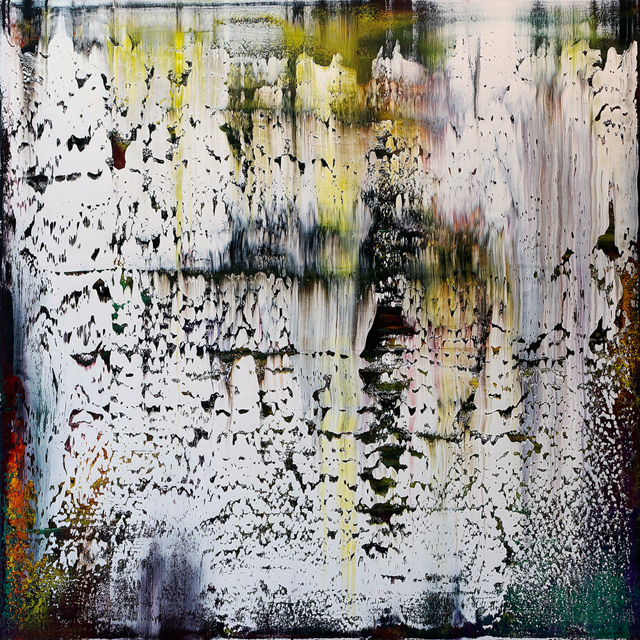
Bello questo Richter, no? Peccato, però, che sia un falso. Un falso d’autore. L’ha commissionato Jerry Saltz, il critico d’arte del New York Times, all’artista Stanley Casselman. Saltz, scandalizzato dai prezzi astronomici raggiuntii dall’arte contemporanea, e resosi conto che non si sarebbe mai potuto permettere un’opera d’arte come sarebbe piaciuta a lui, ha pensato di commissionare degli autentici falsi da mettersi in casa. L’idea non è nuova, ma l’articolo è molto divertente. Lo trovate qui.
A un certo punto scrive:
Quando Stanley mi ha aperto la porta, ho visto quelli che sembravano 50 grandi quadri di Gerhard Richter. Mi è subito venuta la fantasia di diventare ricco aprendo un negozio di falsi Richter con lui. Poi ho iniziato a guardare più da vicino. Tutti i quadri sembravano richteriani, ma molti avevano un cotè impressionista, una grazia antirichteriana. Molti sembravano troppo pensati. Le casualità sembravano intenzionali piuttosto che scoperte. Potevo individuare le sue decisioni anziché queste mi prendessero di sorpresa. Richter – che applica la pittura a veli, in strati che traspaiono gli uni negli altri – controlla la casualità con un’intelligenza fisica e sottili cambiamenti di direzione e di tocco, le sue decisioni sono in un incredibile rapporto di botta e risposta con le casualità. I suoi dipinti astratti appaiono come fotografie di quadri astratti. Questo crea anomalie nella tua retina-cerebrale di memoria, e ti fa percepire uno spazio misterioso tra astrazione, casualità, fotografia, processo, natura della pittura, e pittura. Questi quadri non ci riuscivano.
Sempre Salz, sulla sua pagina Facebook scriveva:
«Credo che tutta l’arte dovrebbe costare lo stesso importo.
Davvero.
$ 12.000 per qualsiasi cosa fatta dopo il 2000.
$ 15.000 per qualsiasi cosa fatta tra il 1990 e il 2000.
$ 20.000 per qualsiasi cosa fatta tra il 1980 e il 1990.
$ 25.000 per qualsiasi cosa fatta tra il 1975-1980
$ 30.000 per qualsiasi cosa fatta tra il 1970-1975.
$ 40.000 per qualsiasi cosa fatta tra 1965-1970.
$ 50.000 per qualsiasi cosa fatta tra 1.955-1.965.
$ 75.000 per qualsiasi cosa fatta tra 1945-1955.»
E ancora:
«Esperimento mentale per un’asta
1. Immagina aste in cui i prezzi NON SONO NOTI.
2. Immagina aste in cui gli ACQUIRENTI non sono noti.
3. Immagina aste in cui i VENDITORI non sono noti».
Che ne dite? Ci si divertirebbe allo stesso modo?
A beautiful Richter, isn’t it? It is a pity that it is a fake. A perfect fake. Jerry Saltz, the art critic of The New York Times, commissioned it to artist Stanley Casselman. Saltz, shocked by the astronomical prices achieved by contemporary art, and realizing that he would never have allowed such a work as he would have liked, decided to commission authentic from false to get in the house. The idea is not new, but the article is very entertaining. You can find it here.
At one point he writes:
When Stanley opened his door, I saw what looked like 50 large Gerhard Richters. I immediately had fantasies of getting rich, of opening a Fake Richter shop with him. Then I started looking more closely. All of the paintings seemed Richterian, but many had an Impressionistic, un-Richterian prettiness. Many looked too thought-out. Accidents looked intentional rather than discovered. His decisions stood out instead of taking me by surprise. Richter—who applies paint in scrims, in layers that emerge through one another—controls accident with a physical intelligence and subtle changes of direction and touch; his decisions are in an incredible call-and-response relationship to accidents. His abstract paintings look like photographs of abstract paintings. This creates glitches in your retinal-cerebral memory, so that you perceive this uncanny space between abstraction, accident, photography, process, the nature of paint, and painting. These didn’t.
Always Salz, wrote on his Facebook page:
«I think that all art should cost the same amount.
Really.
$12,000 for anything made after 2000.
$15,000 for anything made between 1990 and 2000.
$20,000 for anything made between 1980 and 1990.
$25,000 for anything made between 1975-1980
$30,000 for anything made between 1970 – 1975.
$40,000 for anything made between 1965-1970.
$50,000 for anything made between 1955 – 1965.
$75,000 for anything made between 1945-1955.»
And again:
«An Auction Thought-Experiment
1. Imagine auctions where the prices are NOT KNOWN.
2. Imagine auctions where the BUYERS are not known.
3. Imagine auctions where the SELLARS are not know».
What do you think? We would enjoy it the same way?